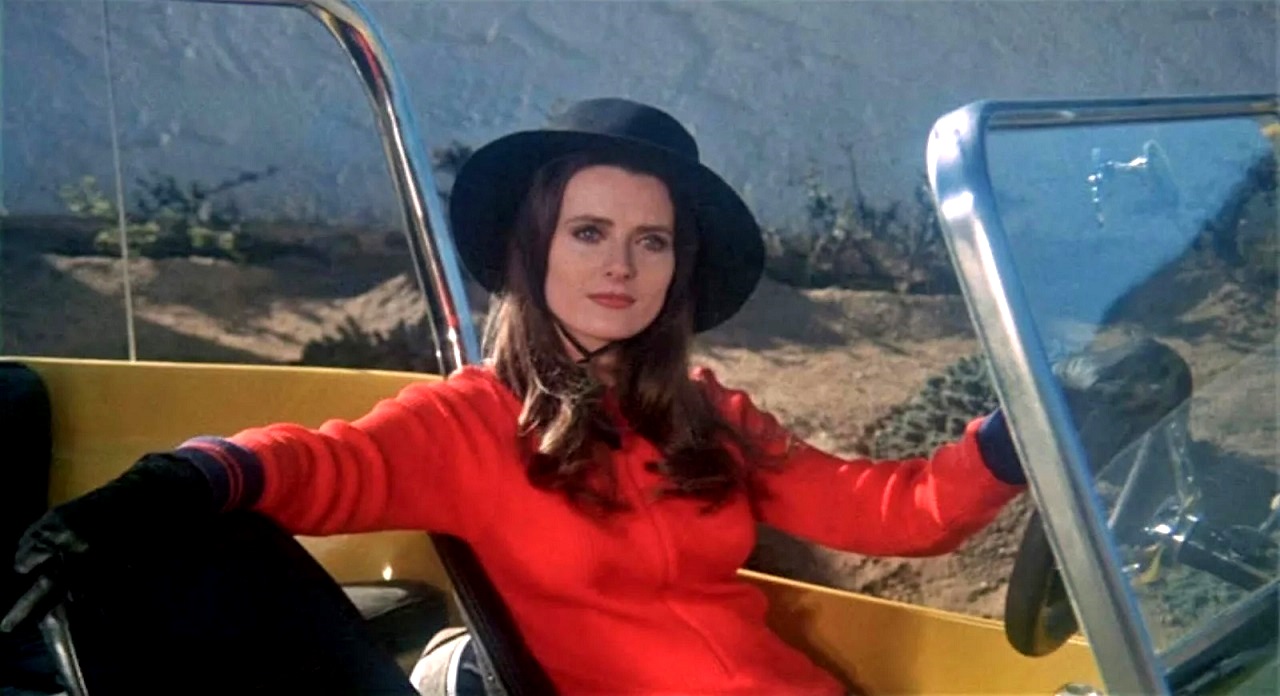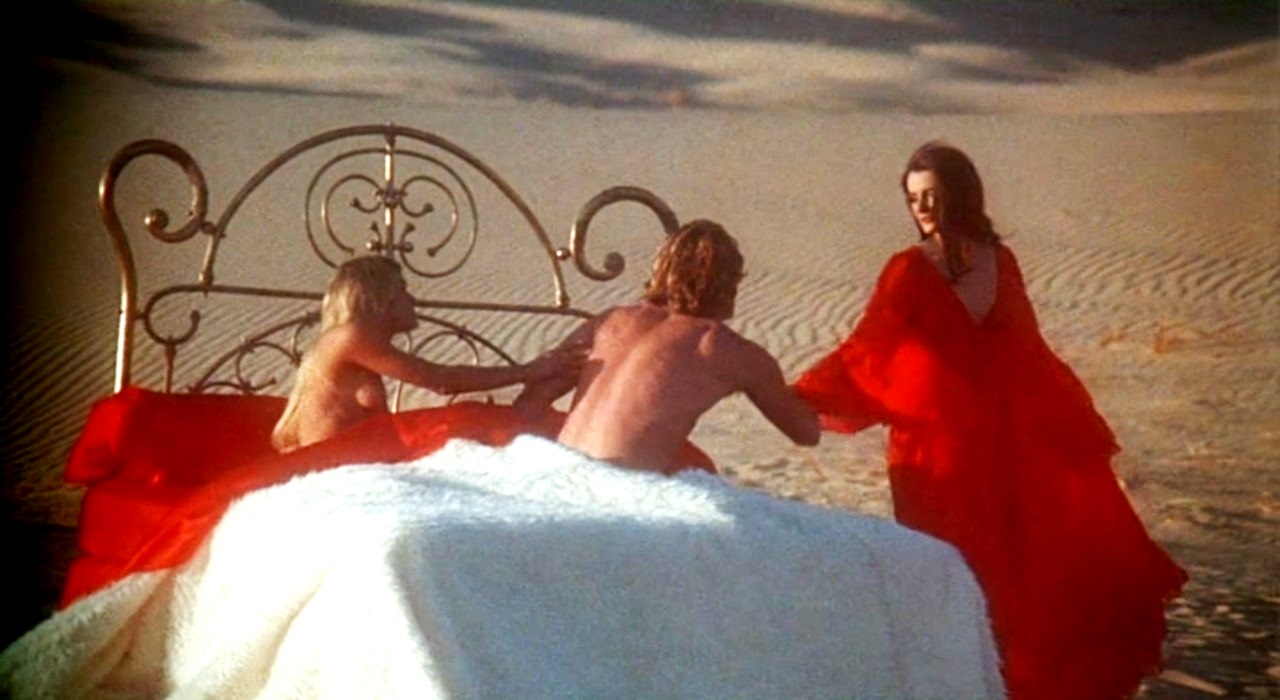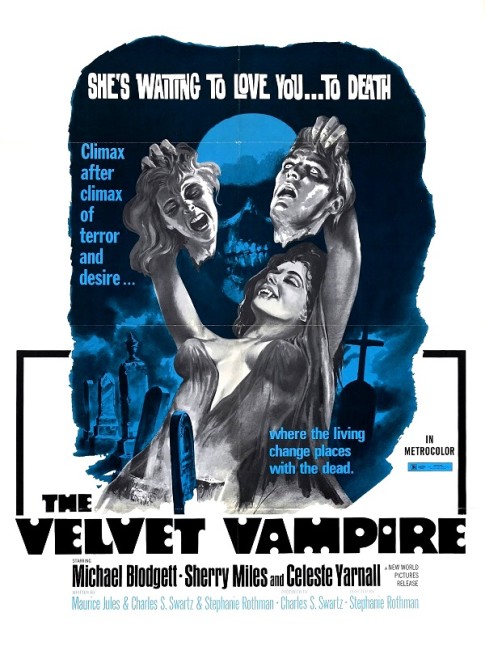USA. 1971.
Crew
Director – Stephanie Rothman, Screenplay – Maurice Jules, Stephanie Rothman & Charles S. Swartz, Producer – Charles S. Swartz, Photography – Daniel LaCambre, Music – Roger Dollarhide & Clancy B. Grass III, Art Direction – Teddi Peterson. Production Company – New World Pictures.
Cast
Celeste Yarnall (Diane Le Fanu), Michael Blodgett (Lee Ritter), Sherry Miles (Susan Ritter), Gene Shane (Carl Stoker), Jerry Daniels (Juan), Sandy Ward (Amos), Paul Prokop (Cliff), Chris Woodley (Cliff’s Girl)
Plot
Husband and wife Lee and Susan Ritter meet Diane Le Fanu at a gallery opening in Los Angeles. They accept Diane’s offer to visit her and travel out into her house in the desert, although their car breaks down in the nearby town. At Diane’s place, they both have dreams in which they are seduced by her. As Lee surrenders to Diane’s temptations, they uncover increasing evidence that leads them to conclude that she is a vampire.
Stephanie Rothman is a director who has attained a cult following. She was one of the first woman directors to work for a US studio. Rothman started working for Roger Corman in the 1960s and first directed sections of Blood Bath (1966), followed by It’s a Bikini World (1970) and The Student Nurses (1970). The Velvet Vampire, also made under the aegis of Corman’s New World Pictures, was a modest hit for her. She and husband Charles Swartz were subsequently partners in the establishment of Dimension Films in 1971, which went on to release a bunch of exploitation films. There Rothman directed Group Marriage (1973), Terminal Island (1973) and The Working Girls (1974), as well as wrote Beyond Atlantis (1973).
The early 1970s gave us a spate of lesbian vampire films. The way was started with Hammer’s The Vampire Lovers (1970), which was successful enough that they made it into a trilogy with Lust for a Vampire (1971) and Twins of Evil (1971). The fad was quickly copied in Europe by filmmakers who pushed things much further with the likes of Vampyros Lesbos (1970), Daughters of Darkness (1971), The Blood Spattered Bride (1972), The Daughter of Dracula (1972) and Vampyres (1974). (For a greater overview of the genre see Vampire Films).
The film makes the homage overt in naming the vampire Diane Le Fanu after Irish writer J. Sheridan Le Fanu’s whose short story Carmilla (1872) was the first lesbian vampire work and formed the basis for The Vampire Lovers. As with a number of these films – Daughters of Darkness, The Blood Spattered Bride – there is the recurrent theme that the vampire woman’s open (bi)sexuality is something that drives a wedge between the couple in a traditional marriage.


The Velvet Vampire does offer perhaps the unusual novelty of being the only vampire film in which we ever see the vampire of the show’s vehicle of choice not being a hearse or horse-drawn carriage but a dune buggy. (We even get flirtation between Celeste Yarnall and Michael Blodgett at one point that offers a bizarre series of innuendoes comparing taking a ride in the dune buggy to sex). Rothman’s direction of the erotic content is about average, if maybe tamer than some of the abovementioned European entries of this period.
The film does suffer from a slow pace. Once the couple arrive at the house in the desert, nothing much happens for a long time. Things are perked up by Rothman’s visual sense – the dream scenes with Michael Blodgett and Sherry Miles on a bed in the middle of the desert as Celeste Yarnall appears out a mirror, or of Yarnall stretched out on the top of her husband’s coffin. Or even the opening scene where Yarnall appears to be attacked by a rapist only to turn the tables on him. Rothman emphasises a visual motif where the colour scarlet red appears everywhere throughout the film from Celeste Yarnall’s dresses, red bedsheets in the dream scene, the drapes in the room from where Yarnall spies on the others, red lipstick and a red light from the fountain during the opening scene.
Particularly imaginative is a scene right at the end where Sherry Miles catches a Greyhound back to Los Angeles only to find Celeste Yarnall in the bus with her. She flees through the Greyhound station pursued by Yarnall and out onto the streets. Finally she comes to some Latino section of the city where she is able to grab a crucifix and drive Yarnall back while all the other bystanders come and pick up crucifixes too, surrounding Celeste until she dissolves in the sunlight. The scenes are slightly unwound by the inconsistency of having earlier seen Celeste readily driving around out in the sun a dune buggy but the sequence is vividly impressive for the fact it is one moment in 1970s cinema where we see the vampire film adapting to the modern world.
Trailer here

